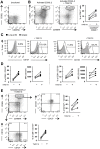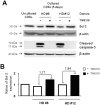Stimulation of Wnt/ß-catenin pathway in human CD8+ T lymphocytes from blood and lung tumors leads to a shared young/memory phenotype
- PMID: 22859966
- PMCID: PMC3408435
- DOI: 10.1371/journal.pone.0041074
Stimulation of Wnt/ß-catenin pathway in human CD8+ T lymphocytes from blood and lung tumors leads to a shared young/memory phenotype
Abstract
Cancer can be treated by adoptive cell transfer (ACT) of T lymphocytes. However, how to optimally raise human T cells to a differentiation state allowing the best persistence in ACT is a challenge. It is possible to differentiate mouse CD8(+) T cells towards stem cell-like memory (T(SCM)) phenotype upon TCR stimulation with Wnt/ß-catenin pathway activation. Here, we evaluated if T(SCM) can be obtained from human mature CD8(+) T cells following TCR and Wnt/ß-catenin activation through treatment with the chemical agent 4,6-disubstituted pyrrolopyrimidine (TWS119), which inhibits the glycogen synthase kinase-3β (GSK-3β), key inhibitor of the Wnt pathway. Human CD8(+) T cells isolated from peripheral blood or tumor-infiltrating lymphocytes (TIL), and treated with TWS119 gave rise to CD62L(+)CD45RA(+) cells, indicative of early differentiated stage, also expressing CD127 which is normally found on memory cells, and CD133, an hematopoietic stem cell marker. T(SCM) cells raised from either TIL or blood secreted numerous inflammatory mediators, but in lower amounts than those measured without TWS119. Finally, generated T(SCM) CD8(+) T cells expressed elevated Bcl-2 and no detectable caspase-3 activity, suggesting increased persistence. Our data support a role for Wnt/ß-catenin pathway in promoting the T(SCM) subset in human CD8(+) T cells from TIL and the periphery, which are relevant for ACT.
Conflict of interest statement
Figures







Similar articles
-
Effects of Glycogen Synthase Kinase-3β Inhibitor TWS119 on Proliferation and Cytokine Production of TILs From Human Lung Cancer.J Immunother. 2018 Sep;41(7):319-328. doi: 10.1097/CJI.0000000000000234. J Immunother. 2018. PMID: 29877972 Free PMC article.
-
[Activation of Wnt/β-catenin pathway in NK cells by glycogen synthase kinase-3β inhibitor TWS119 promotes the expression of CD62L].Xi Bao Yu Fen Zi Mian Yi Xue Za Zhi. 2015 Jan;31(1):44-8. Xi Bao Yu Fen Zi Mian Yi Xue Za Zhi. 2015. PMID: 25575058 Chinese.
-
Wnt pathway activator TWS119 enhances the proliferation and cytolytic activity of human γδT cells against colon cancer.Exp Cell Res. 2018 Jan 1;362(1):63-71. doi: 10.1016/j.yexcr.2017.11.003. Epub 2017 Nov 16. Exp Cell Res. 2018. PMID: 29104081
-
Activation of Wnt signaling arrests effector differentiation in human peripheral and cord blood-derived T lymphocytes.J Immunol. 2011 Nov 15;187(10):5221-32. doi: 10.4049/jimmunol.1101585. Epub 2011 Oct 19. J Immunol. 2011. PMID: 22013128 Free PMC article.
-
Regulation of mature T cell responses by the Wnt signaling pathway.Ann N Y Acad Sci. 2012 Jan;1247:16-33. doi: 10.1111/j.1749-6632.2011.06302.x. Epub 2012 Jan 12. Ann N Y Acad Sci. 2012. PMID: 22239649 Review.
Cited by
-
New insights into the stemness of adoptively transferred T cells by γc family cytokines.Cell Commun Signal. 2023 Dec 4;21(1):347. doi: 10.1186/s12964-023-01354-3. Cell Commun Signal. 2023. PMID: 38049832 Free PMC article. Review.
-
Asymptomatic memory CD8+ T cells: from development and regulation to consideration for human vaccines and immunotherapeutics.Hum Vaccin Immunother. 2014;10(4):945-63. doi: 10.4161/hv.27762. Epub 2014 Feb 5. Hum Vaccin Immunother. 2014. PMID: 24499824 Free PMC article. Review.
-
Memory stem T cells generated by Wnt signaling from blood of human renal clear cell carcinoma patients.Cancer Biol Med. 2019 Feb;16(1):109-124. doi: 10.20892/j.issn.2095-3941.2018.0118. Cancer Biol Med. 2019. PMID: 31119051 Free PMC article.
-
Tumor-infiltrating lymphocytes are associated with β-catenin overexpression in breast cancer.Cancer Biomark. 2018 Feb 14;21(3):639-650. doi: 10.3233/CBM-170708. Cancer Biomark. 2018. PMID: 29286921 Free PMC article.
-
Transcriptional regulation of effector and memory CD8+ T cell fates.Curr Opin Immunol. 2013 Jun;25(3):321-8. doi: 10.1016/j.coi.2013.05.010. Epub 2013 Jun 6. Curr Opin Immunol. 2013. PMID: 23747000 Free PMC article. Review.
References
Publication types
MeSH terms
Substances
Grants and funding
LinkOut - more resources
Full Text Sources
Other Literature Sources
Medical
Research Materials
Miscellaneous

